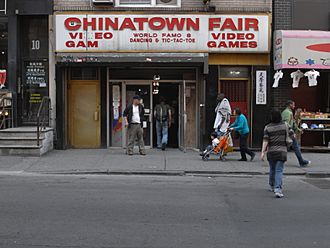Chinatown Fair facts for kids
Quick facts for kids Chinatown Fair Family Fun Center |
|
|---|---|
 |
|
| Former names | Chinatown Fair |
| General information | |
| Type | Video arcade |
| Address | 8 Mott St, New York, NY 10038 |
| Town or city | Chinatown, Manhattan, New York City |
| Country | United States |
| Coordinates | 40°42′50″N 73°59′55″W / 40.714009°N 73.998511°W |
| Opened | 1944 |
The Chinatown Fair Family Fun Center is a famous video arcade in New York City. It is located on Mott Street in Chinatown, Manhattan. For many years, this arcade was known for its exciting competitive fighting games.
The original Chinatown Fair opened way back in 1944. It closed for a short time in 2011 but reopened in 2012 with new owners. Many people consider Chinatown Fair to be one of New York City's most important arcades.
Contents
History of Chinatown Fair
Chinatown Fair first opened its doors in 1944. It took over the first floor of a popular Chinese restaurant building. At first, it was a "penny arcade." This meant you could play games for just a penny! It also had a small museum.
In the 1970s, the arcade started to focus on video games. An immigrant from India named Sam Palmer bought the business in 1982.
Fun Attractions and Games
One of the arcade's first big attractions was a dancing chicken! Later, this chicken was replaced by one that could play tic-tac-toe. The tic-tac-toe chicken retired in the early 2000s.
In the 1970s and 1980s, Chinatown Fair had many classic games. These included Pac-Man and Space Invaders. In 1991, a new game called Street Fighter II: The World Warrior came out. After this, Chinatown Fair became famous for competitive fighting games.
By the late 1990s, many popular fighting games were played there. These included Street Fighter, Marvel vs. Capcom, The King of Fighters, Soulcalibur, and Tekken. Some of the best players in the world, like Justin Wong and NYChrisG, often visited the arcade.
The Decline of Arcades
Around 2010, The New York Times newspaper wrote about Chinatown Fair. They said it was one of the last big video arcades in New York City. This is because home video games became very popular. More and more people started playing games at home instead of at arcades.
Chinatown Fair became a special place for people who loved classic arcade games. It was a place where players could meet and share their passion. Games like the original Street Fighter II and Ms. Pac-Man were still very popular there. Other groups of players enjoyed Dance Dance Revolution and racing games.
Closing and Reopening
In February 2011, Chinatown Fair closed down. Many fans were sad to see it go. But a little over a year later, in May 2012, it reopened! It had a new name: "Chinatown Fair Family Fun Center." It also had a new manager, Lonnie Sobel.
Some of the old competitive players felt the new arcade was different. They thought it was more for casual players. Many competitive fighting game players moved to a new arcade in Brooklyn called Next Level. This arcade was opened by Chinatown Fair's old manager in 2011.
Chinatown Fair was even featured in a movie! A documentary called The Lost Arcade was made about the arcade in 2015. It was released in New York City in 2016.

